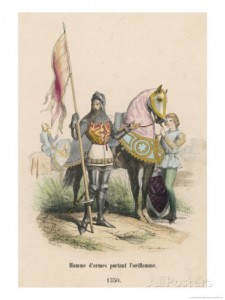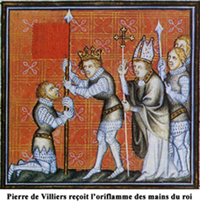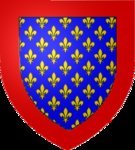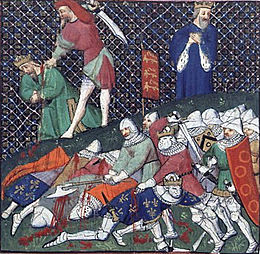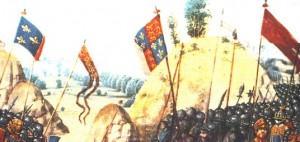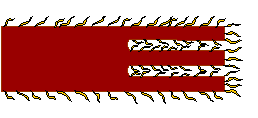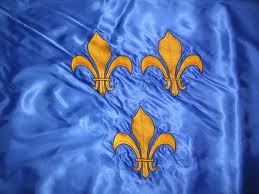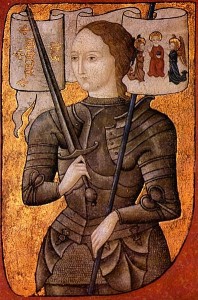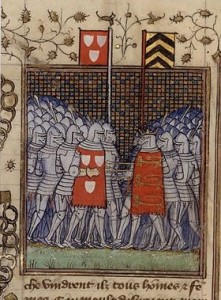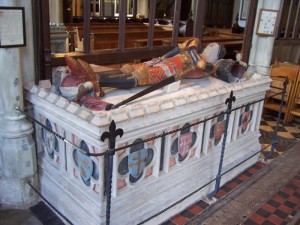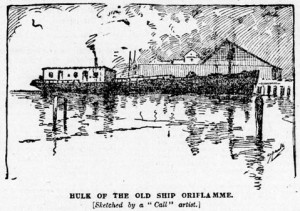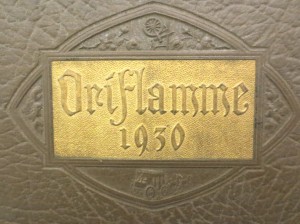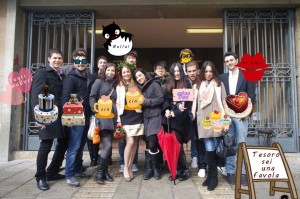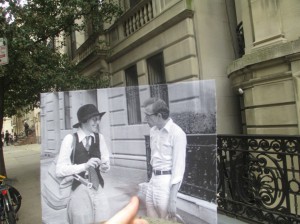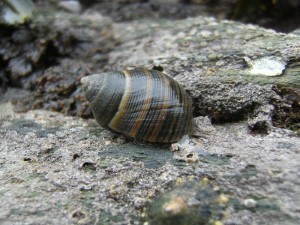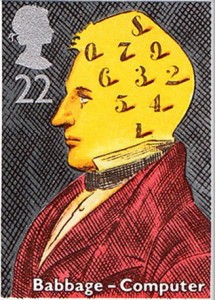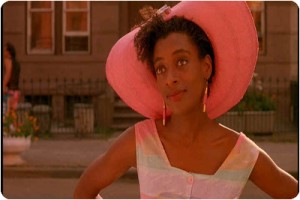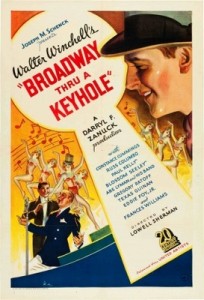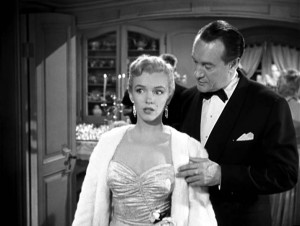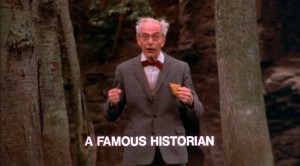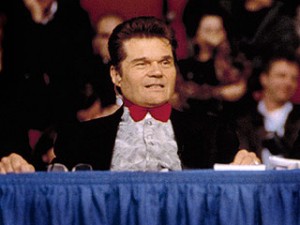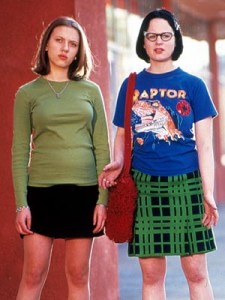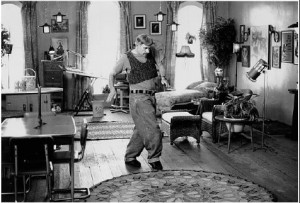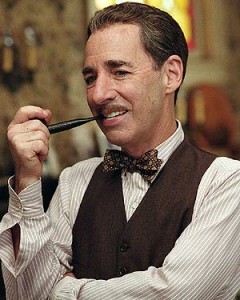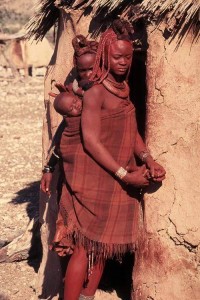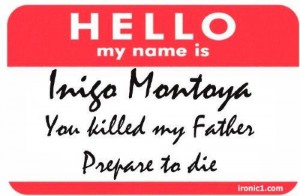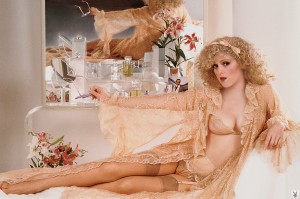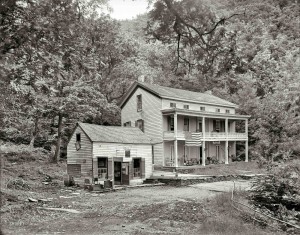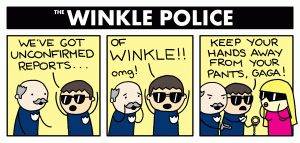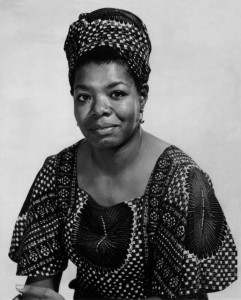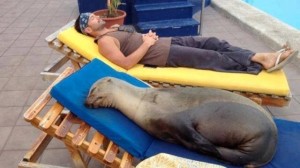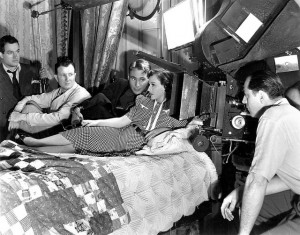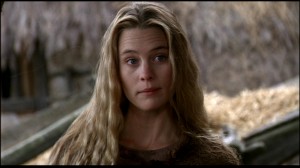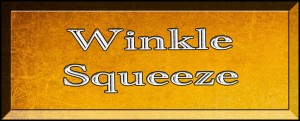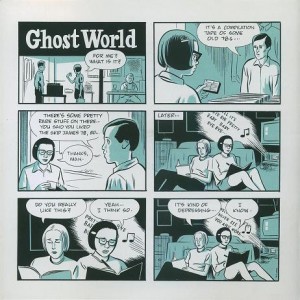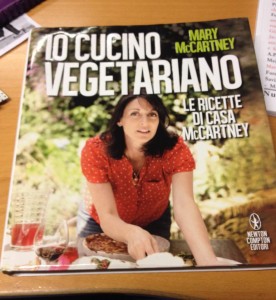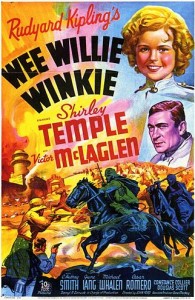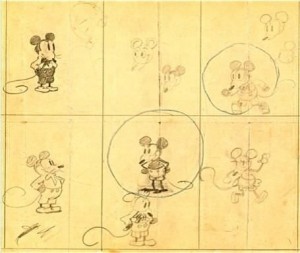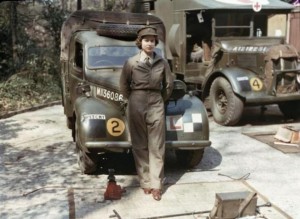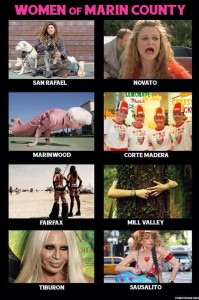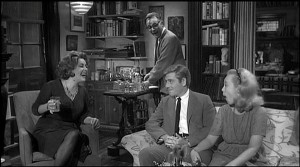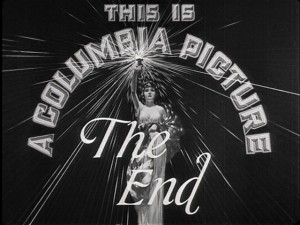The Oriflamme or Or-y-flamme (Latin aurea flamma, la flamme d’or, the golden flame) was the battle standard of the king of France in the Middle Ages.
It was originally the sacred banner of the Abbey of Saint Denis a monastery near Paris where many French monarchs are entombed.
In French, the term oriflamme has come to mean any banner with pointed ends, the form of the original.
The Oriflamme was mentioned in the eleventh century ballad la Chanson de Roland as a royal banner.
The oriflamme was first called Romaine and then Montjoie.
According to legend, Charlemagne carried the oriflamme to the Holy Land in response to a prophecy regarding a knight possessing a golden lance, from which flames would burn and drive out the Saracens.
The idea of the golden lance suggests that the lance was originally the important object, with the banner simply a decoration, but this changed over time. The flag attached to the spear became more important than the spear itself.
The Oriflamme was first used by Louis VI in 1124 and was last flown in battle at Agincourt in 1415, though a version of it remained in the Abbey of St. Denis until the 18th century.
Louis VI replaced the earlier banner of Saint Martin with the oriflamme of the Abbey of St. Denis, which floated about the tomb of St. Denis and was said to have been given to the abbey by Dagobert, the first Frankish king to be buried in the Saint Denis Basilica.
Until the 12th century the standard-bearer was the Comte de Vexin, who, as vowed to St. Denis, was the temporal defender of the abbey.
Louis VI, having acquired Vexin, became standard-bearer. As soon as war began, Louis VI received Communion at St. Denis and took the oriflamme from the tomb of Saint Denis to carry it to the combat.
The oriflamme was red or orange-red silk and flown from a gilded lance. Here the oriflamme has fallen in battle and may be seen near the fleur de lys standard.
According to legend, the color of the oriflamme stems from it being dipped in the blood of the recently-beheaded St. Denis.
When the Oriflamme was displayed on the battlefield it indicated that no quarter was to be given, its red color being symbolic of cruelty and ferocity.
Although the azure ground (from the blue cape of St. Martin of Tours) strewn with gold fleur de lys remained the symbol of royalty until the 15th century, the Oriflamme became the royal battle standard of the King of France, and it was carried at the head of the king’s forces when they met another army in battle.
In the fifteenth century, the fleur-de-lys on the white flag of Jeanne d’Arc became the new royal standard replacing both the symbol of royalty and the Oriflamme on the battle field.
The bearer of the standard, the porte-oriflamme, became an office (like that of Maréchale or Connétable of France) and a great honor, as it was an important and very dangerous post to take charge of such a visible symbol in battle. If things went badly, the porte-oriflamme was expected to die rather than abandon his duty.
There Sir Geoffroi de Charny fought gallantly near the king and his fourteen year old son. The whole press and cry of battle were upon him because he was carrying the king’s sovereign banner, the Oriflamme. Sir Geoffroi also had before him his own banner, gules, three escutcheons argent. So many English and Gascons came around him from all sides that they cracked open the king’s battle formation and smashed it. There were so many English and Gascons that at least five of these men at arms attacked one French gentleman. Sir Geoffroi de Charny was killed with the banner of France in his hand, as other French banners fell to earth. Froissart
Winkle: a small herbivorous shore dwelling mollusc with a spiral shell or to extract or to obtain something with difficulty
I had always thought of winkle as British slang, light and trivial for ‘to get something out of a tight place, as a cubbyhole,’ as in, “Could you winkle those keys out from between the seats?”
But, then, the other day I saw a sentence: King John was forever trying to winkle Richard Coeur de Lion out of prison in Germany. This was a much more serious usage than I had expected.
I couldn’t winkle out why someone would use this term that seriously and in an academic context yet.
The verb is derived from the process of extracting a winkle (periwinkle) from its shell.
Little boys sometimes call their penis a winkle unless they’re in Japan where they call it a chin chin. Cin cin (sounds exactly the same) is an Italian drinking toast like Salute! So, in Japan, if you raise your cup and say Cin, cin, you will often get a big laugh.
Go vote. It’s important.
I swore I wasn’t going to tell her, but she winkled it all out of me
In the late 16th century, periwinkle was shortened to winkle.
Antonia and Victoria managed to winkle the details out of him.
To worm out, to prize out, to pry out, dig out, extract with difficulty, force out (a shade or two different in meaning), dislodge, displace, remove, evict, uproot.
There were huge profits to be made if the scum of the earth landlords could winkle out the sitting tenants.
She winkled the garnet out from the bedrock.
He winkled that scoundrel out from his rathole.
Maybe we should try to winkle that key out of the door?
In Spanish, a winkle (periwinkle) is a bígaro, but to winkle a secret out of someone is sacar un secreto a álguien.
Surgeons use the word extirpate in a literal way, meaning, to cut out something roots and all. She extirpated the patient’s tonsils. I’m not sure she could ever use the word winkle to describe that operation. The word seems too light and everyday for such a procedure.
From what harmonic hole did they manage to winkle this chord?
A periwinkle is a type of shellfish, shaped like a small snail, eaten as food. Germans call it die Strandschnecke. (Strand = beach).
In Greece, the periwinkle is called a θαλασσινό σαλιγκάρι. That word thalassinó θαλασσινό refers to the ocean, the sea.
In Italy, the people call the common periwinkle or winkle (littorina littorea) una litorina, that is, something that lives on the littoral edge of the water.
For the verb winkle, they say carpire un segreto a qualcuno.
Littorina littorea appears in prehistoric shellfish middens throughout Europe, and is believed to have been an important source of food since at least 7500 BCE in Scotland.
Periwinkle meat is still collected in huge quantities in Scotland, mostly for export to the Continent, and is also consumed locally.
Over 2,000 tons of winkles are exported annually.
This makes winkles the sixth most important shellfish harvested in Scotland in terms of tonnage, and seventh most important in terms of value. However, since actual harvests are probably twice reported levels, the species may actually be the fourth and sixth most important, respectively.
Winkles are usually picked off the rocks by hand or caught in a drag from a boat.
They are mostly eaten in the coastal areas of Scotland and Ireland, where they are commonly referred to as winkles or in some areas buckies, willicks, or wilks.
In Belgium, periwinkles are commonly called kreukels or caracoles.
Winkles are commonly sold in paper bags near beaches in Ireland and Scotland, boiled in their local seawater, with a pin attached to the bag to enable the extraction of the soft parts from the shell.
Periwinkles are considered a delicacy in African and Asian cuisines.
The meat is high in protein, omega-3 fatty acids and low in fat.
Raw snails in general are about 80% water, 15% protein, and 1.4% fat. If you look very closely at this photograph, you will see me sitting on a pier in the West Village watching the tall ships sail up the Hudson for the Bicentennial 1976. It was one of those historical moments, a beautiful day.
Periwinkles are also used as bait for catching small fish. The shell is usually crushed and the soft parts extracted and put on a hook.
Color my day, let’s pick a hue. Periwinkle blue? Or, really, whatever hues you might choose.
Rip van Winkle Hotel in the Catskills: The shanty on the left is the original house from 1826. The boarding house on the right was built in 1867. The place has a fascinating history.
My life has been one great big joke, a dance that’s walked, a song that’s spoke, I laugh so hard I almost choke when I think about myself.
I think of winkles, first of all, the oyster-killing marine snails, themselves edible. Then the verb for getting the little beggars out of their shells. The periwinkle is one kind of winkle. The periwinkle is also a ground-cover plant with blue flowers. Periwinkle is fun to say and fun to see. That hue of blue looks good on you.
Winkle can also mean scintillate or twinkle.
In spite of all the crap, there will always be reasons for being happy, and the word winkle is one of them.
Winkle pickers: Phrase used to describe shoes that are very narrow and pointy.
Roger Winkle is a practicing Cardiovascular Disease doctor in Redwood City, California.
See that little girl? She sang with us in Central Park in 2003. She did a good job too.
Her name is Simone and I had a lot of laughs with her.
After a hard day winkling out molluscs from the rocks near the Cliffhouse, San Francisco, she enjoys a well deserved siesta.
A winkle can be a mysterious part of your body that tells you when you’re turned on. It turns pink when it’s the most excited.
Robert Matthew Van Winkle better known by his other name, Vanilla Ice, is an American rapper, actor and television host.
Rip ran to the old inn where he once gathered with friends. But instead of a shade tree there was a pole with a strange flag adorned in stars and stripes. And the name of the inn had changed from King George Inn to General Washington Inn.
Vanilla Ice is not the same person as Andrew Dice Clay.
You know, that story by Washington Irving is very deliciously told. It might be worth your while to reread it one of these days. You think you know the story, and yet you don’t.
I bet Saul Bellow read it once or twice, even if he was from Chicago and loved to ride the El.
The Tale of Mrs. Tiggy-Winkle is a children’s book written and illustrated by Beatrix Potter. Mrs. Tiggy-winkle is a hedgehog washerwoman who lives in a tiny cottage in the fells of the Lake District.
From a review of The Third Man: Holly himself has a lot of trouble with names, calling Calloway Callahan, not knowing James Joyce, calling Winkel “winkle.” “Winkel” means “angle” in German, with the suggestion of something crooked or twisted. “Winkle” as an English verb is the process of wriggling a periwinkle, also a “winkle,” out of its shell.
It was difficult for that chick to winkle out of her shell.
Arrancar means: to boot, to bootstrap, to break off, to extract, to pull up, to start, to switch on, to winkle, to wrench, and ‘wrench,’ can you feel it? is actually the same word as arrancar. Arracher in French. Un arracheur de dents was a tooth puller.
Difficult to winkle out the secrets of the universe when we can’t even see 95% of it.
Henry Wadsworth Longfellow was a Spanish professor at Harvard. He didn’t like teaching but he translated Rip Van Winkle and called it Andrés Gazul. If he came anywhere near the flavor, atmosphere and richness of the original, his Spanish was very good indeed.
Tyler Winklevoss studied Latin and Greek at Harvard.
Audrey and her deer one winkling out a box of pasta.
I knew her sister Heather. Believe it or not, Heather was an unusual name in those days.
A ‘wee sleekit’ mouse.
She winkled out various dirty bits out of the distributor cap and did a fine job in the motor pool.
Uh, oh.
See you next week?
Sam Andrew
________________________________________________



